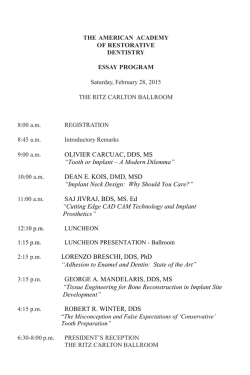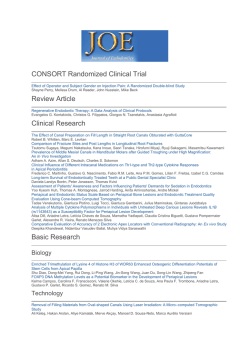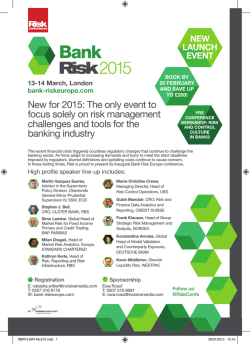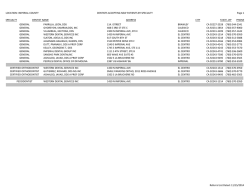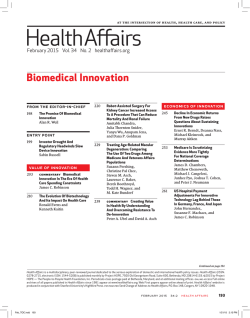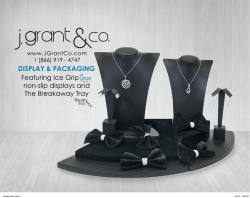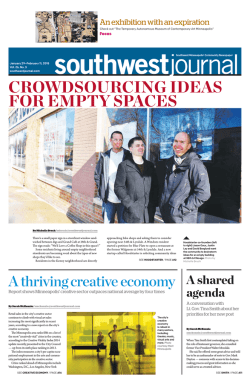
2015 Program Booklet - Final - The International Academy of
ANNUALMEETING MEETING ANNUAL THE FAIRMONT HOTEL THE FAIRMONT HOTEL Dallas, Texas Dallas, Texas January 31 & February February 1 and 2, 20141, 2015 i IAE Annual Meeting 2015.indd 1 12/3/2014 3:34:24 PM ii IAE Annual Meeting 2015.indd 2 12/22/2014 9:18:22 AM MISSION: The mission of The International Academy of Endodontics is to improve the oral health of the public by promoting the highest quality of non-commercial endodontic and scientific continuing education for its membership. The Academy encourages its members to pursue scholarship, research and the highest standards of clinical excellence to advance the art and science of endodontics. VISION: Our vision is to create the foremost international endodontic and scientific educational experience for endodontists and their colleagues in dentistry, medicine and science. HISTORY: The International Academy of Endodontics was formed by a group of clinicians committed to the highest standards of continuing education. Believing that clinical excellence is a lifelong pursuit, our members seek out speakers from many areas in biology, medicine and dentistry who are exceptional leaders in their field. The goal of the meeting is to provide advanced knowledge and understanding, to give inspiration through basic science and clinical leadership, and to provide serious mentorship for all attendees. Our goal is to create an environment where endodontic standards can grow to their fullest fruition. The membership has been kept small by design and will not exceed 125 members. Attendance is by invitation only. The programs include long and short oral presentations that serve to integrate basic and clinical science on topics directly or indirectly related to endodontics. The IAE meets at the same time and in the same location each year in Dallas. Our organization is a public, non-profit organization and accepts no commercial affiliations. 1 IAE Annual Meeting 2015.indd 1 12/22/2014 9:18:22 AM INTERNATIONAL ACADEMY OF ENDODONTICS January 31 & February 1, 2015 THE FAIRMONT HOTEL Dallas, Texas MEETINGS OF THE INTERNATIONAL ACADEMY OF ENDODONTICS FRIDAY, JANUARY 30, 2015 Officer Breakfast 8:00 a.m. Executive Committee and Council Meeting 1:00-4:00 p.m. Credential and Nominating Committee Meeting 1:00-2:00 p.m. Scientific Program Committee Meeting 4:00-5:00 p.m. Annual Membership Meeting 5.30-6.30 p.m. Membership Social 6.30-8.00 p.m. SATURDAY, JANUARY 31, 2015 President’s Reception 6:30-8:00 p.m. SUNDAY, FEBRUARY 1, 2015 Program Committee 2:00 p.m. FUTURE MEETING DATES The Fairmont Hotel January 30-31, 2016, January 28-29, 2017, January 27-28, 2018 CONTINUING EDUCATION The International Academy of Endodontics is an ADA CERP recognized provider. The two-day meeting totals 9 credit hours. 2 IAE Annual Meeting 2015.indd 2 12/22/2014 9:18:22 AM THE INTERNATIONAL A CADEMY OF ENDODONTICS LONG ESSAY PROGRAM SATURDAY January 31, 2015 8:00 a.m. REGISTRATION 8:40 a.m. Introductory Remarks 9:00 a.m. STANLEY PRUSINER, MD ** “Prions Causing Neurodegeneration” 11:00 a.m. RALF SCHULER DR, MED, DENT, MS ** “Atraumatic Tooth Extraction and Extraction Socket Management” 12:00 p.m. LUNCHEON – STANLEY PRUSINER, MD ** “A First Person History of a Scientific Revolution – The Discovery of Prions.” 2:00 p.m. CHARLES MCNEIL, DDS ** “Nonodontogenic Sources of Tooth Pain” 3:00 p.m. MAHENDRA RAO, MBBS, MD, PhD “The Field of Regenerative Medicine” 4:00 p.m. FRANK PAQUE, DR. MED. DENT., M.Sc. ** “Complex Root Canal Anatomy and Its Impact on Shaping Procedures” 6:30-8:00 p.m. PRESIDENT’S RECEPTION **Speaker reports no conflict of interest. 3 IAE Annual Meeting 2015.indd 3 12/22/2014 9:18:22 AM LONG ESSAY PROGRAM SATURDAY, JANUARY 31, 2015 9:00 a.m. STANLEY PRUSINER, MD 675 Nelson Rising Lane San Francisco, CA 94143 E-mail: [email protected] Professor of Neurology Director, Institute for Neurodegenerative Diseases University of California San Francisco, CA “Prions Causing Neurodegeneration” Mounting evidence argues that prions feature in the pathogenesis of many, if not all, neurodegenerative diseases. Such disorders include Alzheimer’s, Parkinson’s, Lou Gehrig’s and Creutzfeldt-Jakob diseases as well as the frontotemporal dementias. In each of these illnesses, aberrant forms of a particular protein accumulate as pathological deposits referred to as amyloid plaques, neurofibrillary tangles, Lewy bodies, as well as glial cytoplasmic and nuclear inclusions. The heritable forms of the neurodegenerative diseases are often caused by mutations in the genes encoding the mutant, aberrant proteins that accumulate in the CNS of patients with these fatal disorders. The late onset of the inherited neurodegenerative diseases seems likely to be explained by the protein quality control systems being less efficient in older neurons and thus, more permissive for prion accumulation. To date, there is not a single drug that halts or even slows one neurodegenerative disease. Attendees will learn: 1. About the growing epidemic of neurodegenerative diseases. 2. E vidence showing that prions are the cause of most neurodegenerative diseases. 3. H ow effective therapeutics that halt neurodegeneration are being developed. 4 IAE Annual Meeting 2015.indd 4 12/22/2014 9:18:22 AM 11:00 a.m. RALF SCHULER DR, MED, DENT, MS 5309 NE 85th St. Affiliate Associate Professor Seattle, WA 98115 Department of Periodontics E-mail: [email protected] University of Washington Seattle, WA “Atraumatic Tooth Extraction and Extraction Socket Management” Conventional approaches to tooth extraction often result in the loss of hard and soft tissue volume leading to esthetic and functional shortcomings. Recent surgical protocols and armamentaria have dramatically changed our approach to tooth extraction and alveolar ridge management. This course is designed for the dental practitioner who would like to further his/her knowledge of atraumatic tooth extraction techniques and learn about the principles of minimally invasive alveolar ridge preservation procedures, including immediate placement protocols. Attendees will learn: 1. A review of socket anatomy, periodontal biotypes and how it relates to wound healing following extraction therapy. 2. The different extraction techniques/armamentaria for maximum bone preservation following tooth extraction. 3. To understand the relevance and limitation of ridge preservation techniques including the use of bone grafts and membrane application. 12:00 p.m. LUNCHEON PRESENTATION STANLEY PRUSINER, MD “A First Person History of a Scientific Revolution – The Discovery of Prions.” 2:00 p.m. CHARLES McNEIL, DDS UCSF Center for Orofacial Pain Professor Emeritus & Director Dept. Oral and Maxillofacial Surgery UCSF Center for Orofacial 513 Parnassus Ave., Rm S-738 Pain San Francisco, CA 94143 San Francisco, CA E-mail: [email protected] “Nonodontogenic Sources of Tooth Pain” To definitively diagnose nonodontogenic tooth pain disorders, the health provider must have a working knowledge of the trigeminal pain mechanisms 5 IAE Annual Meeting 2015.indd 5 12/22/2014 9:18:23 AM including peripheral and central sensitization. Because a number of orofacial pain conditions can masquerade as tooth pain, endodontists must consider other diseases unrelated to the teeth in their differential diagnosis. Management of nonodontogenic neuropathic tooth pain requires a thorough diagnostic process, because an incorrect or omitted diagnosis is one of the most frequent causes of treatment failure. Attendees will learn: 1. To identify risk factors associated with nonodontogenic tooth pain. 2. H ow to begin the initial management for the most common types of nonodontogenic tooth pain. 3. How to properly triage the refractory chronic neuropathic pain patient. 3:00 p.m. MAHENDRA RAO, MBBS, MD, PhD 15 Wilderfield Ct. Timonium, MD 21093 E-mail: [email protected] Vice President for Regenerative Medicine New York Stem Cell Foundation New York, NY “The Field of Regenerative Medicine” The regenerative medicine field remains united conceptually in that the players are all motivated to use cells, engineered cells, cells combined with devices, and cell derivatives for treating disorders. However, the field is diverse encompassing everything from cell-derived products that are not regulated, to somatic cell products and products derived from stem cells. These products are being used in innovative ways that, in some cases, represent incremental change from existing activity or a small extension of expertise; examples of this are seen in the blood banking and marrow transplant industries. While other changes are completely novel uses of new types of cells including neural stem cells, mesenchymal stem cells, and, more recently, induced pluripotent stem cells. Perhaps the most radical change has been the newest results on somatic cell nuclear transfer, which offer an opportunity to treat mitochondrial diseases, and the development of technology to make three–D biological and engineered composites. Attendees will learn: 1. A brief history of stem-cell advancements. 2. The safety issues with stem-cell therapy and how clinical trials are designed. 3. The useful therapies expected to flow from stem-cell technology. DISCLOSURE: New York Stem Cell Foundation 6 IAE Annual Meeting 2015.indd 6 12/22/2014 9:18:24 AM 4:00 p.m. FRANK PAQUE, DR. MED. DENT., M.Sc. University of Zurich Zurich, Switzerland E-mail: [email protected] “Complex Root Canal Anatomy and Its Impact on Shaping Procedures” Root canal anatomy is very complex and variations of number and arrangement of root canals are significant in many tooth groups. Root canal treatment of teeth with complex anatomy requires not only basic knowledge about variations in the number of root canals but also knowledge about the possible unique arrangement of the canals. The three-dimensional imaging of teeth using micro-computed tomography is very helpful for the clinician to learn about complex anatomy. Furthermore, scanned teeth can be kept intact and the impact of endodontic procedures on root canal anatomy can be analyzed. Besides the evaluation of alterations of root canals after preparation with different instruments, side effects like hard tissue debris accumulation into non-instrumented areas can be displayed and calculated. Attendees will learn: 1. To detail the possible anatomical variations in human teeth. 2. To describe the impact of complex root canal anatomy on shaping procedures. 3. To describe the ability of different chemo-mechanical preparation systems to shape and clean complex root canal anatomy. ALTERNATE KEITH KANTER, DDS ESSAYIST Private Practice 4861 S. Orange Ave. Orlando, FL 32806 E-mail: [email protected] “Surgical Pearls” This presentation will include a series of surgical tips that will improve outcomes as well as patient experience. 7 IAE Annual Meeting 2015.indd 7 12/22/2014 9:18:24 AM Attendees will learn: 1. To methodically evaluate surgical treatment goals. 2. How to execute an organized series of tasks to enable optimal surgical results. 3. To understand principles of soft tissue surgeries to enhance hard tissue treatments. 8 IAE Annual Meeting 2015.indd 8 12/22/2014 9:18:24 AM THE INTERNATIONAL ACADEMY OF ENDODONTICS SHORT ESSAY PROGRAM SUNDAY FEBRUARY 1, 2015 8:00 a.m. 9:00 a.m. DRUMMOND RENNIE, MD** “Who Wrote My Paper?” CHARLES MAUPIN, DDS** “Decision Making: Endodontic Treatment or Dental Implant” 9:20 a.m. CHARLES MASTROVICH, DDS** “Principles to Manage and Retrieve Fractured Implant Abutment Screws” 9:40 a.m. KEVIN IZU, DDS** “Temporary Crown Restorations” 10:00-10.10 a.m. Questions and Answers 10:10 a.m. ROBERT J. NAPLES, DDS** “Repositioning the Inferior Alveolar Nerve to Facilitate Posterior Mandibular Implant Placement” 10:30 a.m. SCOTT WEED, DDS** “Unraveling the Mysteries of Nitinol” 10:50 a.m. MARCO RAMIREZ-SALOMON, DDS, MS** “Secondary Pathological Effects of the Dental Inlays among the Prehispanic Mayas” 11:10-11:20 p.m. Questions and Answers 11:20 a.m. SASHI NALLAPATI, DDS** “Endodontic Recalls: A Clinical Conundrum” 11:40 a.m. EMMA ALLEN-VERCOE, PhD “Using Microbes as Medicine: Microbial Ecosystems Therapeutics” 9 IAE Annual Meeting 2015.indd 9 12/22/2014 9:18:24 AM 12:00 p.m. MARY CHIEN, DDS** and RAJIV PATEL, DDS** “Surgical Extrusion - Forgotten?” 12:20-12:30 p.m. Questions and Answers 12:40-2.30 p.m. LUNCHEON **Speaker reports no conflict of interest. NOTES: 10 IAE Annual Meeting 2015.indd 10 12/22/2014 9:18:24 AM SHORT ESSAY PROGRAM SUNDAY, FEBRUARY 1, 2015 8:00 a.m. DRUMMOND RENNIE, MD 9627 Sterling Creek Rd. Jacksonville, OR 97530 E-mail: [email protected] “Who Wrote My Paper?” Adjunct Professor of Medicine The PR Lee Institute for Health Policy Studies University of California San Francisco, CA Science does not exist until it is published in full, and can then be subjected to criticism and replication by others. The written paper is therefore an intrinsic part of the research. Authorship is the coin of advancement along the academic toll-road, and competition to get published in high-impact journals is fierce. As an editor at two of the highest impact general medical journals, I have witnessed numerous forms of deceptive uncollegial behaviors, varying from duplicate publication, failure to declare conflicts of interest, ghost and guest authorship, and failure to acknowledge the work of others, all the way to fabrication and falsification of data, and plagiarism. The single common factor is failure to take seriously the fundamental responsibilities authors bear towards their readers and each other, so no one is accountable. I have been deeply involved with efforts to rectify the problem and increase the integrity of the scientific literature on which our treatments are based. These range from setting up definitions of research misconduct, to strengthening accountability by putting in place systems to ensure that the contributions actually made by each co-author are declared to the reader. Attendees will learn: 1. That science does not exist until it has been published in full, and can then be subjected to criticism and replication by others, so the written paper is an intrinsic part of the research. 2. To understand how big general medical journals function, and that because of their prominence, attain the highest impact factors, and attract the best and most competitive new research, which in turn attracts more excellent research. 3. To understand that authorship is the coin that allows a scientist to 11 IAE Annual Meeting 2015.indd 11 12/22/2014 9:18:24 AM advance along the academic toll-road, and that, perhaps as a downside of competition, this increases the incentives for various forms of deceptive uncollegial behaviors, varying from duplicate publication, failure to declare conflicts of interest, ghost and guest authorship, and failure to acknowledge the work of others, all the way to fabrication and falsification of data, and plagiarism. 4. Understand efforts being made to strengthen the bond between author and reader, and to increase the integrity of the published work on which clinical practice is based. 9:00 a.m. CHARLES MAUPIN, DDS Private Practice 6010 82nd St., Ste. 300 Lubbock, TX 79424 E-mail: [email protected] “Decision Making: Endodontic Treatment or Dental Implant” The decision to preserve a tooth and perform endodontic treatment or remove the tooth and place a dental implant can be very challenging for the clinician. Patient factors as well as site specific factors should guide the clinician in the decision process. These key factors will be discussed from the view of an endodontist/implantologist. Attendees will learn: 1. Criteria to critically evaluate the decision to perform endodontic treatment or place a dental implant. 2. Patient specific factors. 3. Site specific factors. 4. Treatment planning of the questionable tooth. 12 IAE Annual Meeting 2015.indd 12 12/22/2014 9:18:25 AM 9:20 a.m. CHARLES MASTROVICH, DDS Private Practice 911 E. Grand Ave. Escondido, CA 92025 E-mail: [email protected] “Principles to Manage and Retrieve Fractured Implant Abutment Screws” This presentation will clarify the clinical dilemma of retrieving fractured components from otherwise stable and functional implants. The mechanical algorithm discussed will clearly allow the clinician to effectively evaluate the difficulty of a case to avoid common clinical errors which can rapidly escalate into a difficult iatrogenic problem, or worse, create a non-useable implant. Attendees will learn: 1. How to evaluate the difficultly of a fractured screw case before attempting retrieval. 2. Retrieval techniques to apply to different clinical situations; what to do and what not to do. 3. Specialized tooling necessary for success in difficult cases. 9:40 A.M. KEVIN IZU, DDS Private Practice 3501 Town Center Blvd South Sugarland, TX 77479 E-mail: [email protected] “Temporary Coronal Restorations” Our endodontic goal of long term preservation of teeth relies heavily on proper restorative treatment upon completion of endodontic therapy. There are many things that can be done immediately following endodontic treatment that may improve the long term outcome of the teeth that we treat. This short presentation will show how and why temporary coronal restorations can and should be used in an endodontic practice. 13 IAE Annual Meeting 2015.indd 13 12/22/2014 9:18:26 AM Attendees will learn: 1. P roblems that may arise from the lack of a coronal restoration following root canal therapy. 2. The benefits of placing temporary coronal restorations in an endodontic practice. 3. A simple method to fabricate a temporary coronal restoration following endodontic treatment. 10:00-10:10 a.m. Questions and Answers 10:10 a.m. ROBERT J. NAPLES, DDS Private Practice 1950 Round Rock Avenue Round Rock, TX 78681 E-mail: [email protected] “Repositioning the Inferior Alveolar Nerve to Facilitate Posterior Mandibular Implant Placement” There are times when it is advantageous to reposition the inferior alveolar nerve in order to achieve ideal implant placement. However, there are complications that can arise as a result of the procedure, such as paresthesia or anesthesia. This presentation will focus on the clinical procedure of repositioning the inferior alveolar nerve and how to deal with post-operative complications that can result from manipulation of the nerve. Attendees will learn: 1. How to reposition the inferior alveolar nerve. 2. Advantages of nerve repositioning surgery when compared to bone grafting in the severely resorbed mandible. 3. The complications that can occur during the procedure, and the estimated frequency of these complications, and how to manage complications associated with the procedure. 14 IAE Annual Meeting 2015.indd 14 12/22/2014 9:18:26 AM 10:30 a.m. SCOTT WEED, DDS Private Practice SS White Key Opinions Group 1015 Maplewood Dr. Reno, NV 89511 E-mail: [email protected] “Unraveling the Mysteries of Nitinol” Nitinol is an alloy we use every day in our practices. Many misconceptions and mischaracterizations exist in endodontics about nitinol. We will be reviewing some history of the material and the properties that are so useful to what we do clinically. Attendees will learn: 1. The proper terms for the properties of nitinol. 2. How endodontic files are manufactured. 3. The anatomy of file fracture. DISCLOSURE: SS White 10:50 a.m. MARCO RAMIREZ-SALOMON, DDS, MS Calle 14 No. 114 por Av. Cupules García Ginerés Merida, Yucatan 97070 Mexico E-mail: [email protected] Chair and Advanced Program Director Department of Endodontics Autonomous University of Yucatan “Secondary Pathological Effects of the Dental Inlays among the Prehispanic Mayas” There is much evidence of a high frequency of dental procedures among the Prehispanic Mayan population. The filling of teeth and recovery of intact cemented inlays are evidence of some of these dental procedures. It is surprising that after many centuries, quite a few of these restorations have been discovered in situ, leading us to infer a low failure frequency of these restorative procedures. The purpose of this lecture is to show the ancient Mayan dental inlays secondary pathological effects and the potential use of the Mayan cement in dentistry. 15 IAE Annual Meeting 2015.indd 15 12/22/2014 9:18:26 AM Attendees will learn: 1. Mayan population had a high frequency of dental procedures performed within their population. 2. Mayan dental inlays induced secondary pathology. 3. The material used to cement the inlays of this population was very retentive and may have potential uses in dentistry today. 11:10-11:20 p.m. Questions and Answers 11:20 p.m. SASHI NALLAPATI, BDS Private Practice Suite 56, 15 Hope Rd Kingston 00010 Jamaica E-mail: [email protected] “Endodontic Recalls; A Clinical Conundrum” The most satisfying aspect of clinical endodontics is to see the long-term success of the treatment you performed on your patient. The only way a clinician can critically evaluate his or her clinical technique is by looking at the long-term outcome of the said technique. There shall be invaluable lessons to be learnt from these short, medium and long-term recalls. Recalls are also useful in connecting with your patients in a specialty where patients are usually seen only on a need to basis. However, one may argue clinical techniques are constantly evolving, and how relevant are the recalls of a technique that may be different from your current clinical protocol? How do we interpret the findings in a meaningful manner that will enhance your clinical decision making process, refine your present clinical technique, and offer your patients clinical solutions that are backed by your long- term recalls. Does the current endodontic clinical outcome data help us make these critical analyses? How successful are we in performing this critical aspect of our clinical practice? Are our recalls mostly done on patients that return to have treatment on another tooth? How do we make more sense out of the data from these random recalls? Can we put in place techniques that will make endodontic recalls more predictable? 16 IAE Annual Meeting 2015.indd 16 12/22/2014 9:18:26 AM Attendees will learn: 1. The significance of endodontic recalls in a clinical endodontic practice. 2. Role of current clinical outcome data in the assessment of short, medium and long-term outcomes of our therapies? 3. How to critically analyze the clinical recall data. 4. Techniques that improve our recalls in our clinical practice. 11:40 p.m. EMMA ALLEN-VERCOE, PhD University of Guelph Guelph, Ontario Canada E-mail: [email protected] “Using Microbes as Medicine: Microbial Ecosystems Therapeutics” This presentation will introduce the audience to the human gut microbiota, and its pivotal role in the maintenance of health. The collateral effects of antibiotics on this microbial ecosystem will be illustrated by the example of antibiotic-associated colitis. A new paradigm in medicine, microbial ecosystem therapeutics, designed to correct ecosystem damage, will also be introduced. Attendees will learn: 1. T hat gut microbiota is critical to human health and exists in a delicate state of balance. 2. That antibiotic use can irreversibly damage the microbial equilibrium resulting in disease. 3. A novel and effective approach to curing disease lies in restitution of the microbial ecosystem. DISCLOSURE: NuBiyota, LLC 17 IAE Annual Meeting 2015.indd 17 12/22/2014 9:18:26 AM 12:00 p.m. MARY CHIEN, BDS, MSc(dent)RAJIV PATEL, BDS, DDS “Surgical Extrusion - Forgotten?” Private Practice Private Practice 16388 E. Colima Rd, Ste 111 9241 Blanco Drive Hacienda Heights, CA 91745 Lantana, TX 76226 E-mail: [email protected]: [email protected] Teeth with subcrestal fractures, subgingival caries, resorptions or perforations in the cervical third of the roots are often condemned due to violation of biologic width. Crown lengthening procedure has traditionally been the treatment of choice to re-establish this sacred zone. However, if the margin is close to the osseous crest due to fracture or extensive caries and therefore resulting in excessive ostectomy that will compromise the adjacent teeth, surgical extrusion can be considered. Surgical extrusion involves controlled luxation and extrusion of the roots, it may be compared with extrusive luxation of teeth which has a comparably favorable prognosis with a low incidence of root resorption. It is time to re-emphasize this forgotten dimension of the treatment option. Attendees will learn: 1. What is surgical extrusion? 2. Indications, case selection and armamentarium for surgical extrusion. 3. The biology and mechanics of surgical extrusion. 4. Consideration of risks. 12:20-12:30 p.m. Questions and Answers 18 IAE Annual Meeting 2015.indd 18 12/22/2014 9:18:27 AM ALTERNATE GARY B. CARR, AB, DDS ESSAYIST Private Practice 6235 Lusk Blvd. San Diego, CA 92121 E-mail: [email protected] Founder, TDO Participatory Founder, IAE “Crypt Control Techniques in Endodontic Surgery” A review will be given of the various techniques used to obtain excellent viewing of the resected root end in endodontic surgery. Problems with hemostasis within the crypt will be covered and techniques used to obtain superior vision of the root end in anterior and posterior endodontic surgery. Attendees will learn: 1. Intrinsic and extrinsic clotting pathways. 2. Methods to reduce bleeding in endodontic surgery. 3. S pecific techniques to reduce bleeding and increase visibility within the bony crypt. 12:40-2:30 p.m. LUNCHEON 19 IAE Annual Meeting 2015.indd 19 12/22/2014 9:18:27 AM THE INTERNATIONAL ACADEMY OF ENDODONTICS President Sashi Nallapati President-Elect Steven D. Baerg Secretary/Treasurer Carlos Murgel Immediate Past President Lee Anne Keough COUNCIL 2014-2015 Sashi Nallapati, Chair Mary Chien Robert Goldberg Armando Hernandez-Mejia Rahim Karmali Peter Shelley Michael D. Trudeau COMMITTEES 2014-2015 Scientific Program Admissions Credentials & Nominating Constitution & Bylaws Budget & Finance Literature Review Site Selection & Annual Meeting Professional Conduct and Ethics Public and Professional Relations Website & Photo Roster Gary Carr & Glen Doyon– Co-Chairs Andrew Shur, Chair Lee Anne Keough, Chair Lee Anne Keough, Chair Carlos Murgel, Chair David Figdor, Chair Kevin Mullin, Chair Lee Anne Keough, Chair Lee Anne Keough, Chair Jonathan Richards Chair 20 IAE Annual Meeting 2015.indd 20 12/22/2014 9:18:27 AM 21 IAE Annual Meeting 2015.indd 21 12/22/2014 9:18:27 AM 22 IAE Annual Meeting 2015.indd 22 12/22/2014 9:18:27 AM
© Copyright 2025

